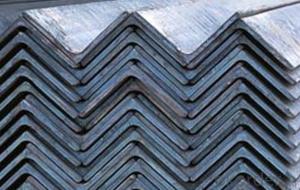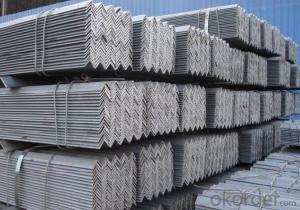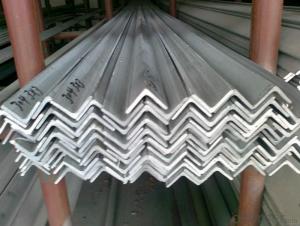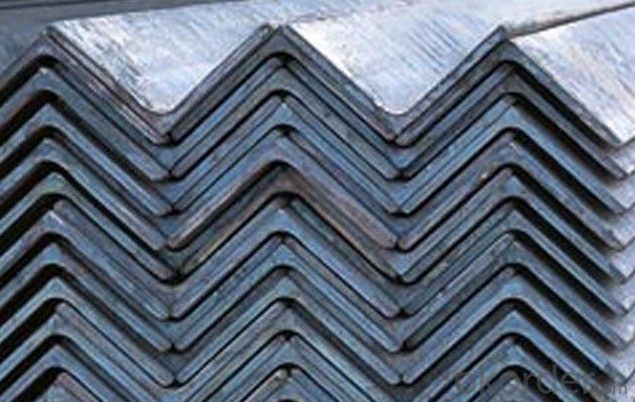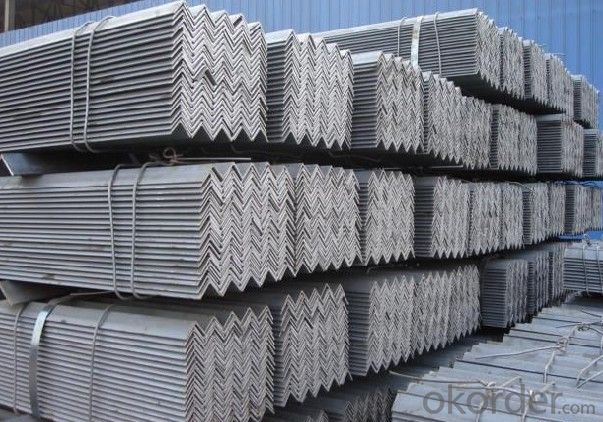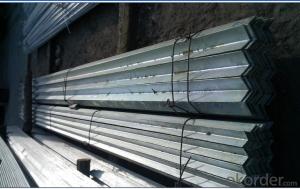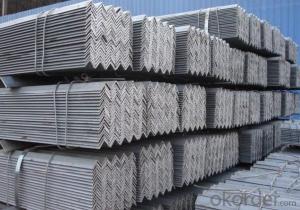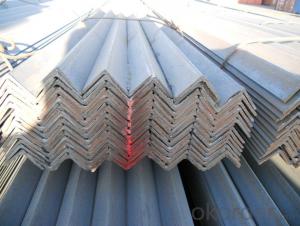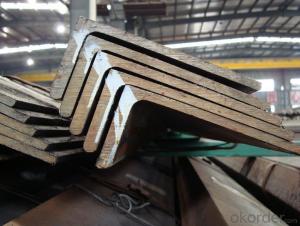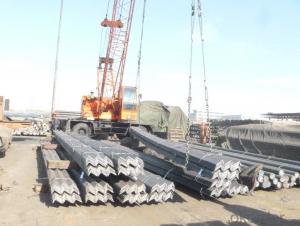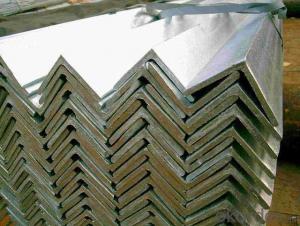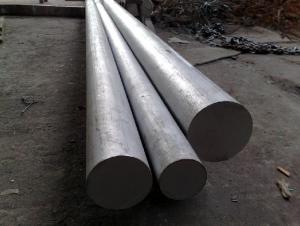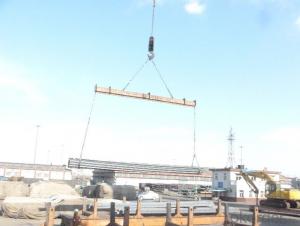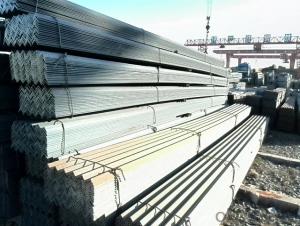High grade hot rolled equilateral angle steel
- Loading Port:
- Tianjin
- Payment Terms:
- TT OR LC
- Min Order Qty:
- 100 m.t.
- Supply Capability:
- 10000 m.t./month
OKorder Service Pledge
OKorder Financial Service
You Might Also Like
Angle called angle, strip steel is perpendicular to each other on both sides into angular.There are equilateral angle steel and unequal angle of. Equilateral angle steel two edge widthequal. The specification is expressed by edge width x edge width * thick edge millimeternumber. Such as "front 30 x 30 x 3", namely said equilateral angle steel edge width of 30 mm,3 mm thick edge. Also available models represent models is the edge width, number of centimeters, such as angle 3#. Models of the same model that in the different edge thickness and size, and thus in the contract documents general boundary angle width, edge thick size fill in complete, avoid use alone model said. Hot rolled equilateral angle steel specifications for 2#-20#. Angle according to the different needs of structure composed of a variety of stress components, but also can be used as a component of the connections between the.Widely used in a variety of architectural and engineering structures, such as beams, bridge,tower, lifting the transport machinery, ships, industrial furnace, reaction tower, container frame and warehouse.
Angle profile
Angle according to the different needs of structure composed of a variety of stress components, but also can be used as a component of the connections between the. Widely used
In a variety of architectural and engineering structures, such as beams, bridge, tower, lifting the transport machinery, ships, industrial furnace, reaction tower, container rack, cable channel support, power piping, bus mounting bracket, and warehouse shelves.
Angle is built with carbon structural steel, is a simple section steel steel, mainly used for metalcomponents and the frame of the plant. In use requires a good weldability, plastic deformation and certain mechanical strength. The production of raw materials for low carbon steel billetsteel billets, finished angle for the hot rolling, normalizing or hot-rolled state of delivery.
Type specification
Mainly divided into equilateral angle steel and equilateral angle steel two categories, includingunequal angle can be divided into equilateral equilateral thick and unequal thickness two.
Angle specifications expressed with side length and edge thickness size. At present domesticsteel specifications for 2 - 20 cm in length, number number, the same horn steel often have 2- 7 different edge thickness. The actual size and edge inlet angle marked on both sides of thethickness and indicate the relevant standards. The general length of more than 312.5px for large angle, 312.5px - 125px for the medium angle, length below 125px for small angle.
Inlet and outlet angle steel orders generally required the use specifications in the main, thesteel is carbon steel grades corresponding. Is the angle in addition to standard number, nospecific composition and performance series. Angle iron delivery length is divided into fixed length, double length two, domestic angle of fixed length of choice scope has 3 9m, 4 12M, 419m, 6 19m four scope according to the specifications of different. Japanese angle length selection range is 6 - 15m.
Section unequal angle height according to the long edge of the width to calculate the scalene angle steel. Refer to section for angular and both sides unequal in length of steel. Is an angleof. Its length from 25mm * 16mm to 200mm * l25mm. From the hot rolling mill and rolling.General specifications for: scalene angle steel angle 50*32-- angle 200*125 thickness of 4-18mm
Unequal angle steel is widely used in all kinds of metal structures, bridges, machinery manufacturing and shipbuilding, building structure and engineering structures, such as beams, bridges, power transmission tower, lifting the transport machinery, ships, industrial furnace, reaction tower, container frame and warehouse etc..
Import and export
China's import and export have a certain angle each batch, mainly imported from Japan andWestern europe. Exports to Hong Kong and Macao, Southeast Asia, the area is mainly on Latin America and Arabia countries etc.. Export production enterprises mainly in Liaoning,Hebei, Beijing, Shanghai, Tianjin and other provinces and cities of iron and steel plant (rolling mill).
Angle for the large variety of imports, small angle and special shape angle, export varieties for the medium angle such as 6, 7, etc..
- Q: Are steel angles fire resistant?
- Yes, steel angles are fire resistant. Steel is a non-combustible material, and when properly designed and installed, steel angles can withstand high temperatures and maintain their structural integrity during a fire.
- Q: What are the different types of connections used for steel angles in commercial applications?
- There are several types of connections used for steel angles in commercial applications, including bolted connections, welded connections, and cleat connections. Bolted connections involve using bolts and nuts to secure the angles together, while welded connections involve fusing the angles together using welding techniques. Cleat connections involve using a separate piece of steel, called a cleat, to connect the angles together. The choice of connection type depends on factors such as the load requirements, design specifications, and ease of installation.
- Q: How do you prevent steel angles from sagging?
- To prevent steel angles from sagging, there are several measures that can be taken: 1. Proper design: Ensure that the steel angles are designed and sized correctly for the load they will bear. This involves considering the span length, the applied load, and the material strength. Consulting with a structural engineer can help determine the appropriate size and thickness of the steel angles. 2. Adequate support: Provide sufficient support for the steel angles at regular intervals along their length. This can be achieved by using intermediate supports such as columns, beams, or braces. The spacing of these supports should be determined based on the load and the properties of the steel angles. 3. Reinforcement: Depending on the load requirements, additional reinforcements can be added to the steel angles. This can include stiffeners, gussets, or flanges to increase their load-carrying capacity and resistance to sagging. 4. Quality fabrication: Ensure that the steel angles are fabricated to meet industry standards and specifications. This includes proper welding techniques, accurate cutting, and appropriate surface preparation to avoid any weak points or defects that may contribute to sagging. 5. Regular inspection and maintenance: Regularly inspect the steel angles to identify any signs of sagging or structural issues. This can involve visual inspections, measurements, and non-destructive testing methods. Promptly address any identified problems to prevent further deformation and ensure the long-term integrity of the steel angles. By following these preventive measures, steel angles can be effectively protected against sagging and maintain their structural stability over time.
- Q: What is the maximum deflection allowed for a steel angle?
- The maximum deflection allowed for a steel angle depends on various factors such as the specific application, the load applied, and the desired safety factor. However, as a general guideline, the maximum deflection allowed for a steel angle is typically limited to 1/360th of its span length.
- Q: Can steel angles be used for temporary structures or scaffolding?
- Yes, steel angles can be used for temporary structures or scaffolding. Steel angles are often utilized in construction projects for their strength and durability. They are commonly used to provide structural support and stability in temporary structures and scaffolding systems. Steel angles are versatile and can be easily welded, bolted, or fastened together to create a sturdy and safe temporary structure or scaffolding setup. Additionally, the availability of different sizes and thicknesses makes steel angles suitable for various temporary construction applications.
- Q: What are the common surface treatments for steel angles to enhance corrosion resistance?
- The common surface treatments for steel angles to enhance corrosion resistance include galvanizing, painting, and powder coating.
- Q: How do steel angles contribute to the overall sustainability of a building?
- A building's overall sustainability is enhanced by steel angles in various ways. To begin with, steel angles are constructed from recycled materials, making them a sustainable choice for building purposes. Steel is one of the world's most recycled materials, boasting a high recycling rate. This reduces the necessity for new resources and lessens the environmental impact of extraction and production. Additionally, steel angles offer structural efficiency, enabling them to support greater loads with less material compared to other building materials. This efficiency reduces the amount of steel needed for construction, minimizing the carbon footprint associated with steel production and transportation. Furthermore, steel angles are extremely durable and long-lasting. They possess high resistance to corrosion, fire, and pests, thereby reducing the maintenance and replacement requirements over the building's lifespan. This durability results in reduced waste generation and lower life-cycle costs, ultimately making the building more sustainable in the long term. Moreover, steel angles are versatile and easily reusable or repurposed. In the event of renovation or demolition, salvaging and reusing the steel angles in other construction projects is feasible. This promotes a circular economy approach, minimizing waste generation and contributing to the overall sustainability of the construction industry. Lastly, steel angles possess excellent thermal properties that can enhance a building's energy efficiency. They can be utilized as part of the building envelope, aiding in the reduction of energy consumption for heating and cooling. By improving insulation and airtightness, steel angles contribute to lower energy demand and reduced greenhouse gas emissions. In conclusion, steel angles contribute to a building's overall sustainability through their recycled content, structural efficiency, durability, recyclability, and energy-saving properties. Opting for steel angles in construction allows for resource conservation, waste reduction, and a minimized environmental impact in the built environment.
- Q: Can steel angles be used in HVAC ductwork?
- HVAC ductwork can indeed make use of steel angles. To ensure structural support and reinforcement, ductwork often incorporates steel angles. These angles are frequently employed at corners and joints, reinforcing the ductwork and preserving its shape. Thanks to their durability, strength, and resistance to corrosion, steel angles are highly suitable for use in HVAC ductwork systems. Moreover, their easy weldability and ability to be fastened together allow for effortless installation and customization. Consequently, steel angles serve as a dependable and frequently utilized element within HVAC ductwork systems.
- Q: Are steel angles prone to warping or twisting?
- No, steel angles are not prone to warping or twisting due to their structural stability and strength.
- Q: How do you join steel angles together?
- One common method to join steel angles together is by using welding techniques. This involves heating the joint area to a high temperature and fusing the angles together using a welding electrode or filler material. Welding creates a strong and durable bond between the steel angles, ensuring structural integrity.
Send your message to us
High grade hot rolled equilateral angle steel
- Loading Port:
- Tianjin
- Payment Terms:
- TT OR LC
- Min Order Qty:
- 100 m.t.
- Supply Capability:
- 10000 m.t./month
OKorder Service Pledge
OKorder Financial Service
Similar products
Hot products
Hot Searches
Related keywords
